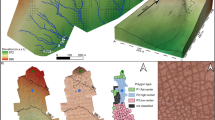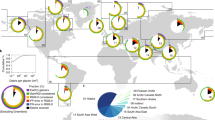Abstract
THIS communication describes certain preliminary observations made on stone polygons in Snowdonia during the summer of 1957, observations which appear to reveal the impermanent character of these structures. The polygon area has been briefly described by Pearsall1; it consists of several connected flat expanses of bare detritus, formed from the erosion of the Juncetum squarrosi occupying the broad ridge between Carnedd Llywelyn and Foel Grach summits in the Carneddau at 915–945 m. The area was casually examined several times during the summer of 1956, but no polygons were observed, the detritus being unsorted. In the course of field work during the first week of July 1957 well-defined stone polygons were noticed over the whole area (Fig. 1); each polygon was 45–60 cm. in diameter, with a centre of fine gravelly detritus and a rim, 10–15 cm. wide, of coarse stone (3–10 cm.); these coarse stones extended downwards for 10–15 cm., finally merging into a matrix continuous with the polygon centres. Ten days later, after predominantly fine weather but with a few days of rain with a blustery north-east wind, it was noticed that a large proportion of the polygons had, by apparent obliteration of the cross-connexions, been converted into stone stripes 2–4 m. long, orientated more or less at right angles to the direction of the prevailing wind (Fig. 2). For much of the remainder of July 1957 the weather was wet, with more or less permanent low cloud. On July 15 there was little change in the polygons. On July 30, however, after a fortnight of heavy rain and strong winds, a large number of the polygons and stripes had been obliterated or were in process of obliteration. On September 3 one of the areas was almost completely unsorted, and many of the stripes on the other areas were indistinct. Polygons were very rare, and the stripes had markedly elongated, extending for many metres without interruption. In July 1958, the next opportunity for a further examination, the area exhibited little change, except qualitatively in that the stone stripes appeared far less elongated.
This is a preview of subscription content, access via your institution
Access options
Subscribe to this journal
Receive 51 print issues and online access
$199.00 per year
only $3.90 per issue
Buy this article
- Purchase on Springer Link
- Instant access to full article PDF
Prices may be subject to local taxes which are calculated during checkout
Similar content being viewed by others
References
Pearsall, W. H., “Mountains and Moorlands”, (Collins, 1950).
Cailleux, A., and Taylor, G., “Actualités scientifiques et industrielles 1203. Expéditions Polaires françaises IV. Cryopédologie, études des sols gelées” (Hermann et Cie., Paris, 1954).
Michaud, J., and Cailleux, A., C.R. Acad. Sci., Paris, 230, 314 (1950).
Author information
Authors and Affiliations
Rights and permissions
About this article
Cite this article
TALLIS, J., KERSHAW, K. Stability of Stone Polygons in North Wales. Nature 183, 485–486 (1959). https://doi.org/10.1038/183485b0
Issue Date:
DOI: https://doi.org/10.1038/183485b0
Comments
By submitting a comment you agree to abide by our Terms and Community Guidelines. If you find something abusive or that does not comply with our terms or guidelines please flag it as inappropriate.



